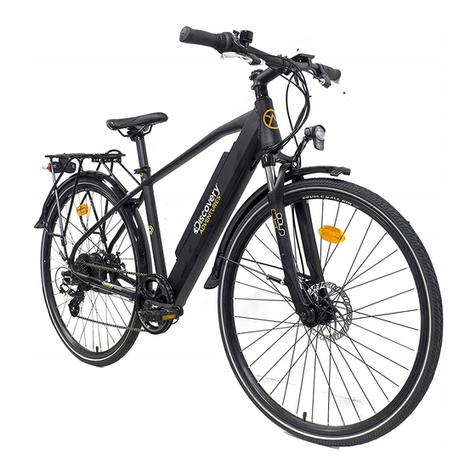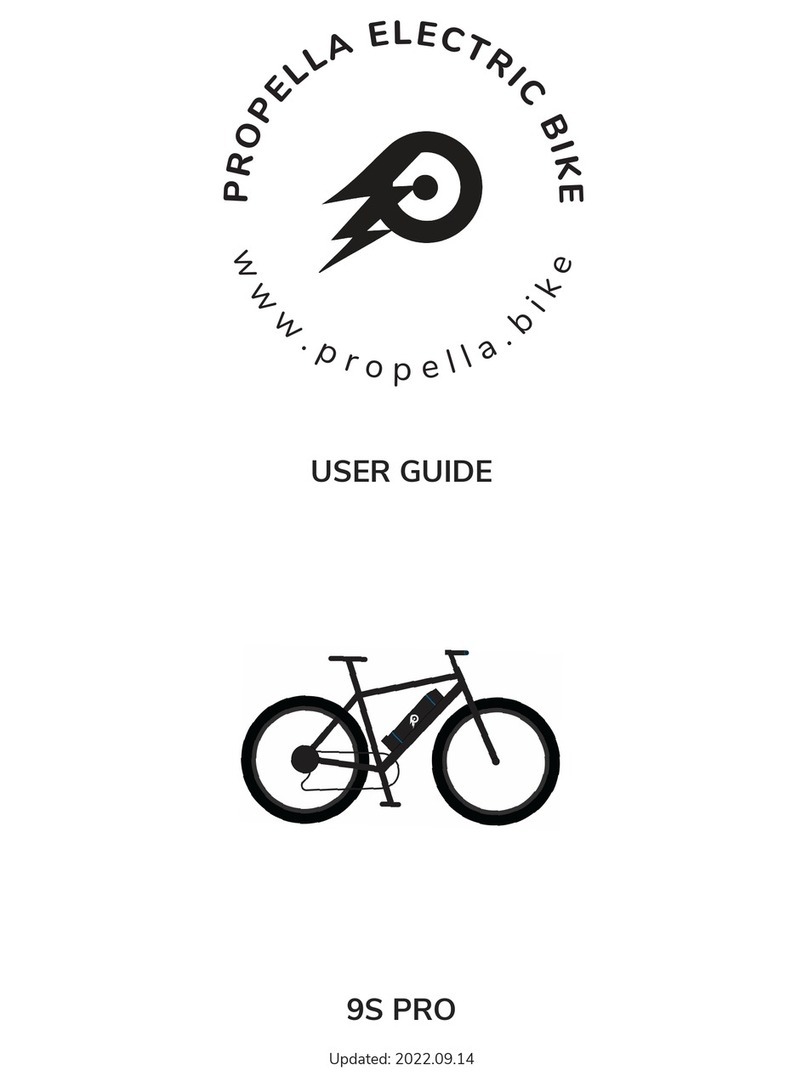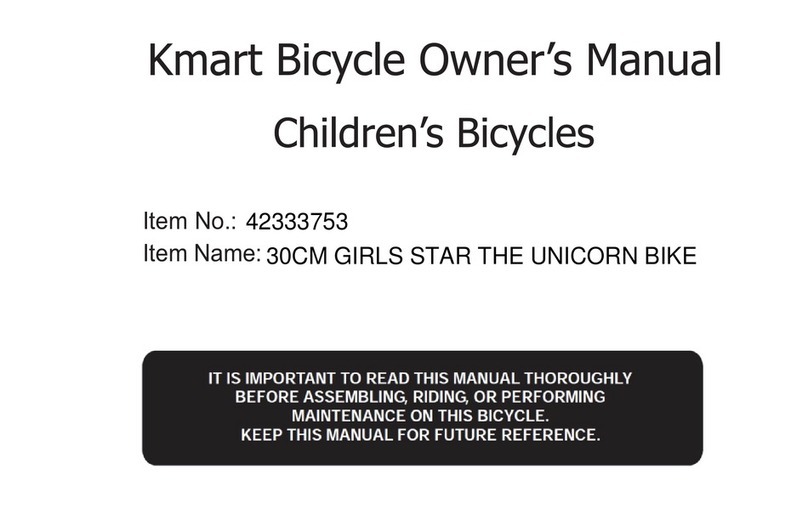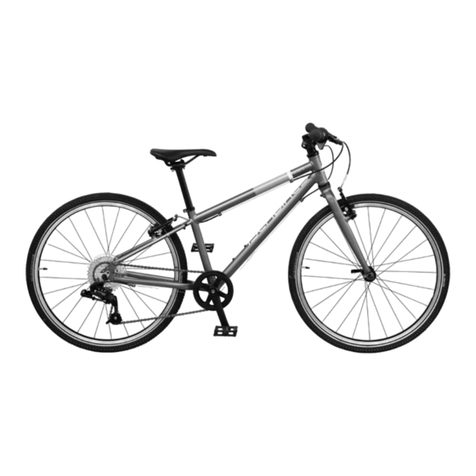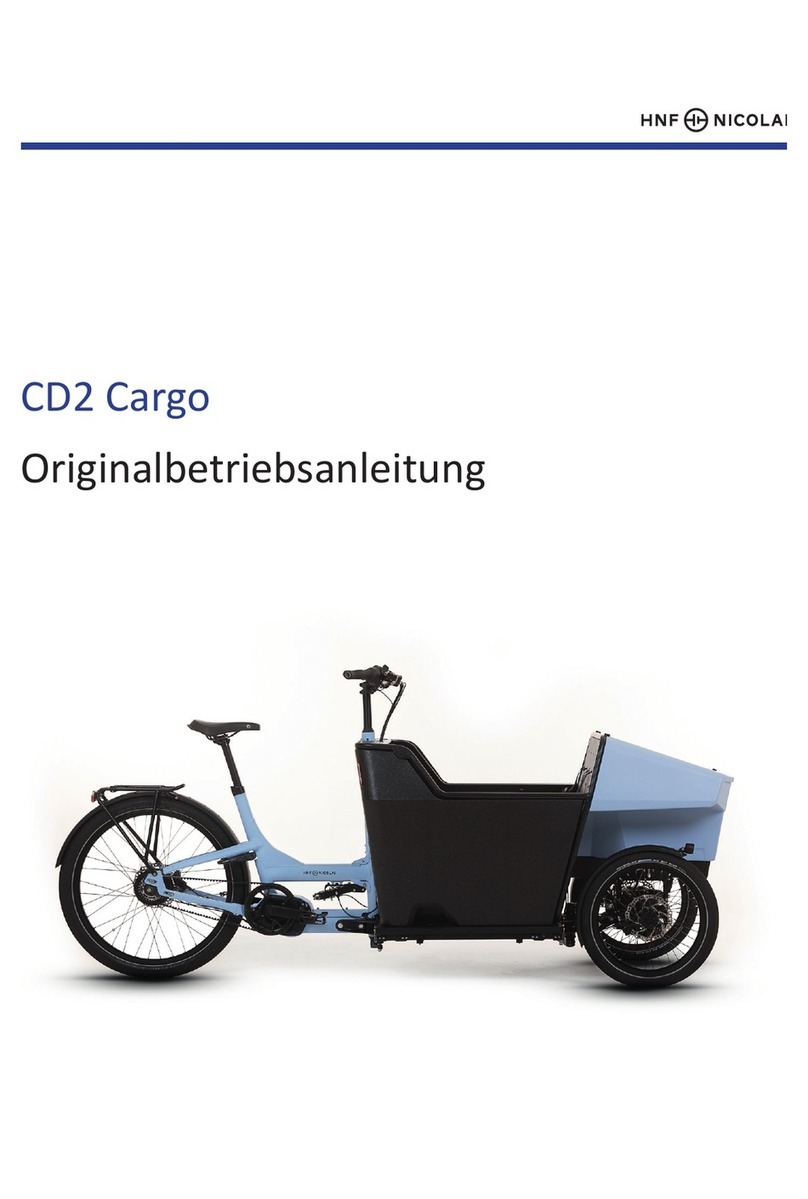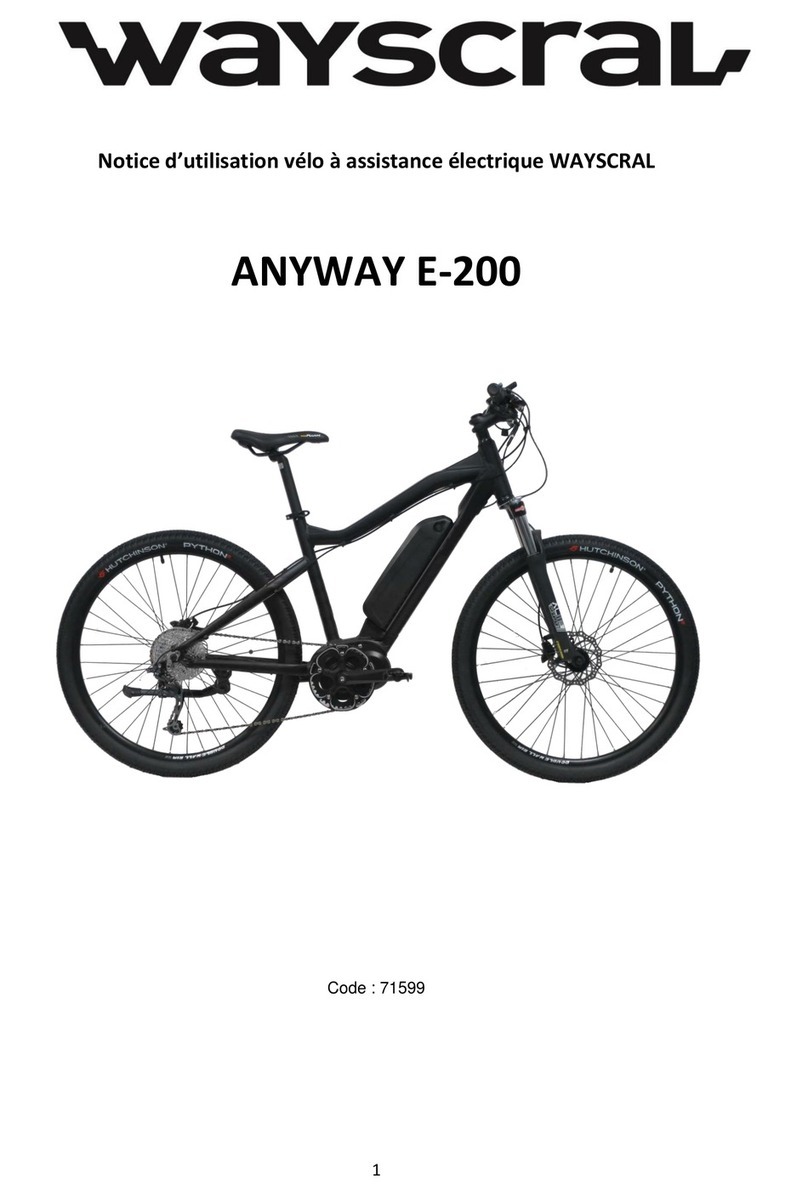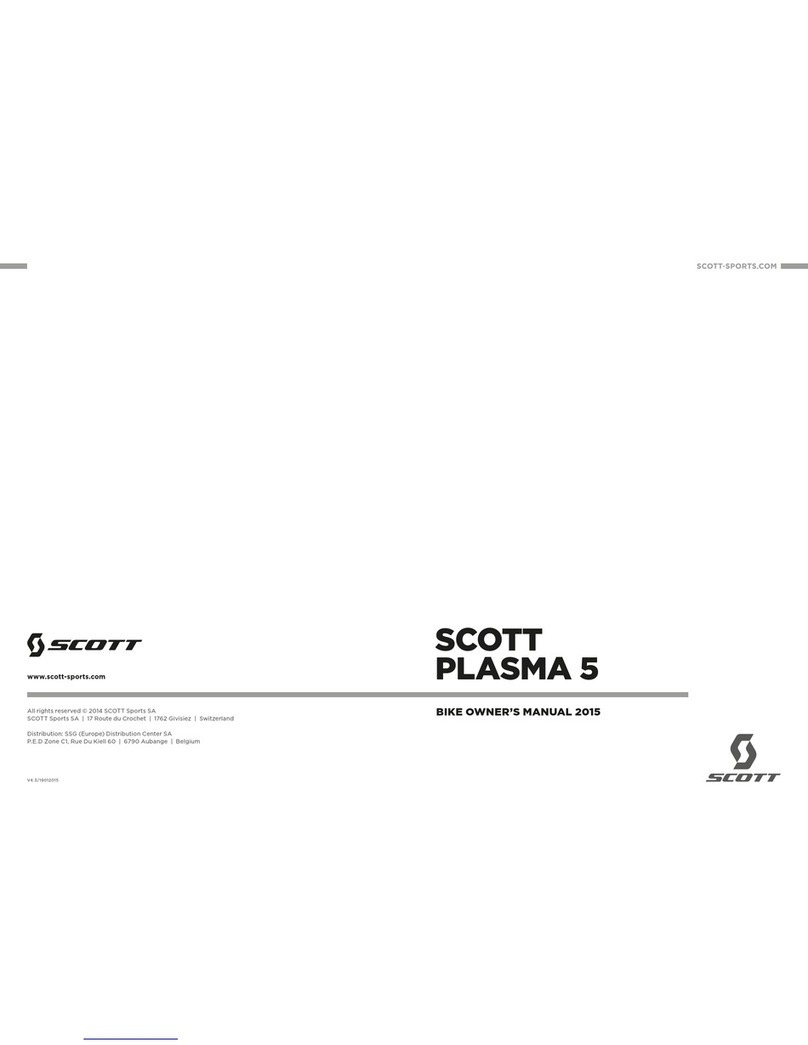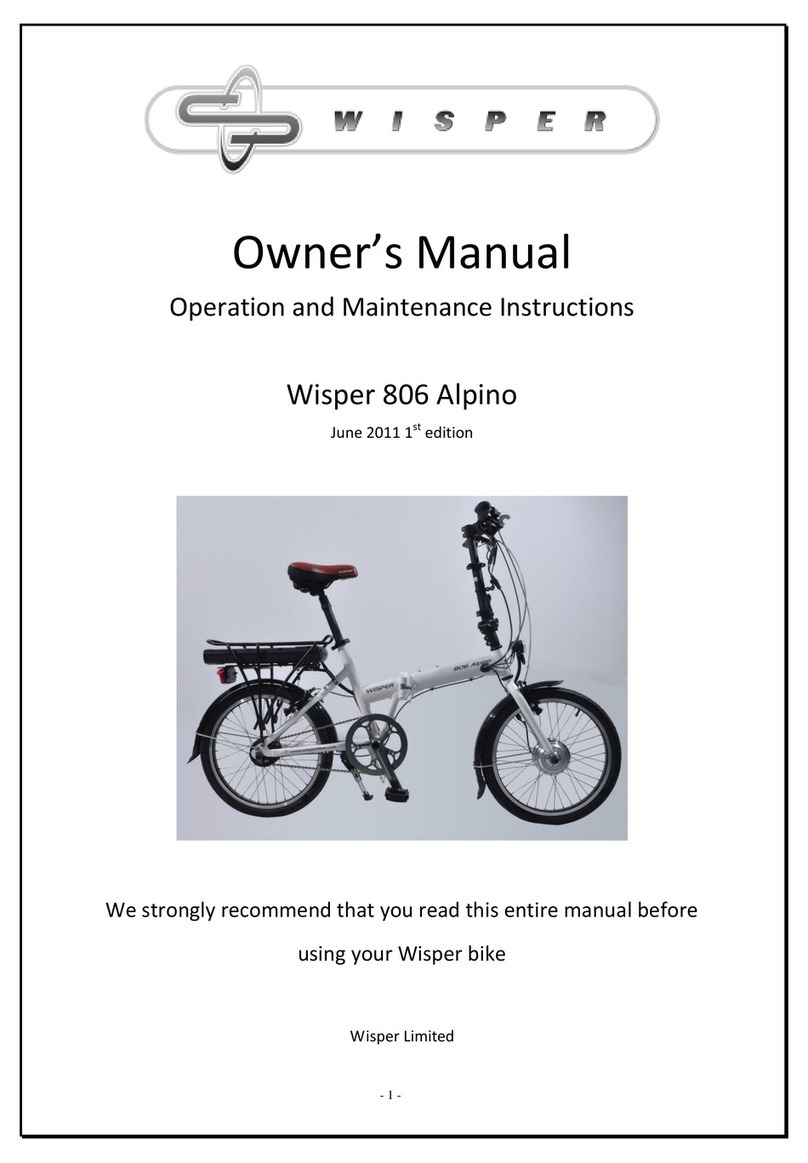SMART ebike User manual

>> ebike.
Translation of the original Owner's Manual

Symbols
* Optional equipment
$Warning
%Environmental note
!Possible vehicle damage
+Tip
XInstructions
YY Continuation symbols
(Y page) Page reference
Display Message in the control console
display
Sticker on the smart ebike
Before using the bike for the
first time, read the Owner's Man-
ual carefully
Warning against potentially
explosive materials

Let the fun begin!
Before taking your first ride, read this
Owner's Manual carefully and familiarise
yourself with your smart ebike. For your
own safety and a longer service life for
your ebike, follow the instructions and
warning notices in this manual. Disre-
garding them may lead to damage to the
ebike or personal injury.
The printed Owner's Manual gives you a
fast, concise overview of your ebike's most
important functions. The electronic Own-
er's Manual on CD gives you detailed infor-
mation on your ebike.
The equipment or product designation of
your ebike may vary according to:
Rmodel
Rorder
Rcountry variant
Ravailability
Items of optional equipment are marked
with an asterisk *.
smart is constantly updating its products
to the state of the art.
smart therefore reserves the right to
introduce changes in the following areas:
Rdesign
Requipment
Rtechnical features
The equipment on your ebike may therefore
differ from that shown in the descriptions
and illustrations.
The following are integral parts of the
ebike:
Rprinted Owner's Manual
Relectronic Owner's Manual on CD
If you sell your ebike, always pass the docu-
ments on to the new owner.
The technical documentation team at
Daimler AG wishes you safe and pleasant
riding.
ohne Éohne-ËÍ


Index ............................................ 4
EU declaration of conformity ............. 7
Introduction .................................. 8
At a glance .................................... 13
Safety .......................................... 17
Controls ....................................... 21
Operation ..................................... 35
Practical advice ............................ 51
Technical data .............................. 69
Contents 3

A
Assistance level
see Drive level
Assistance speed
Maximum .................................. 70
Average speed (control console) ........ 29
B
Battery
Charge level ............................. 27
Charger ................................... 40
Charging ................................. 39
Deep discharge ......................... 39
Fitting the battery .................... 42
Full discharge .......................... 40
Important safety notes ................ 39
Inactive .................................. 40
Notes ...................................... 40
Partial discharge ...................... 40
Problems (malfunctions) ............. 54
Protection mode ........................ 40
Removing the battery .................. 41
Storing ................................... 43
Battery holder ............................... 42
Battery mode
see Drive level
Belt slip guard
Adjustment ............................... 63
see Belt slip guard
Bicycle computer
see On-board computer (control
console)
Bicycle functions
see On-board computer (control
console)
Bicycle valve
Sclaverand valve ....................... 45
Bicycle weight
see Technical data
Bike mode ..................................... 25
Brake assistance
see Brakes
Brake disc
Installing ................................ 65
Brake discs
Checking for wear ...................... 48
Removing ................................. 65
Brake handles
Adjusting ................................ 24
Brake level
see Generator mode
Brake levers
Adjusting the reach ................... 24
Brake pads
Bedding in ............................... 39
Checking (when fitted) ............... 48
Checking (when removed) ............. 48
Installing ................................ 64
Removing ................................. 63
Wear ....................................... 39
Brakes
Braking assistance sensor ........... 38
Driving tips ............................. 37
Front wheel .............................. 38
Rear wheel ............................... 38
Brake system
Problems (malfunctions) ............. 55
C
Care ............................................ 46
Charger
Connecting ............................... 41
Notes ...................................... 40
Cleaning instructions ..................... 46
Continuous rated power
see Technical data
Control console
Checking the battery charge
level ....................................... 27
On-board computer .................... 29
Problems (malfunctions) ............. 53
Removing/inserting ................... 25
Switching on/off ....................... 25
D
Daytime driving lights ................... 26
see Lighting system
Deep discharge .............................. 39
Departure check
see Pre-ride inspection
4Index

Drive assistance
see Pedal-assist technology
Drive belt
Adjusting ................................. 61
Important safety notes ................ 43
Removing/installing .................. 61
Tightening ............................... 61
Drive level
Levels ..................................... 36
Selecting ................................. 27
Drive system
Problem (malfunction) ................ 54
E
Electric motor
Problem (malfunction) ................ 54
Energy
Conserving ............................... 37
Energy recuperation
see Generator mode
EPAC
see Pedelec
F
Front brake
see Brakes
Front wheel
Mounting ................................. 58
Removing ................................. 57
Full discharge .............................. 40
G
Gear cable
Adjusting ................................. 61
Connecting .............................. 60
Gear indicator .............................. 29
Gearshift
Changing gear .......................... 29
Problems (malfunctions) ............. 56
Generator levels ............................ 36
Generator mode
Levels ..................................... 36
Method of operation ................... 12
Selecting the level .................... 28
Grips
Adjusting ................................ 23
Gross weight
see Technical data
H
Headlamp range
Adjusting ................................ 66
Headset
Checking for bearing play ........... 48
I
Inner tubes ................................... 70
J
Journey time (control console) .......... 29
K
Key (battery lock) ........................... 66
Kickstand ..................................... 29
L
Lighting
Adjusting the headlamp range ...... 66
Lighting system
Notes ...................................... 26
Problems (malfunctions) ............. 53
Lights
Switching off ........................... 26
Switching on ............................ 26
Luggage carrier* ........................... 30
M
Maintenance ................................. 47
O
Odometer (control console) .............. 29
On-board computer (control con-
sole) ........................................... 29
Index 5

P
Partial discharge .......................... 40
Pedal assist
Drive levels ............................. 36
Selecting the drive level ............ 27
Pedal-assist technology
Method of operation ................... 11
Pedals ......................................... 24
Pedal sensor .................................. 11
Pedelec ........................................ 11
Pre-ride inspection ....................... 18
Protection mode (battery) ................ 40
Q
Qualified specialist workshop .......... 10
R
Rear brake
see Brakes
Rear wheel
Mounting ................................. 59
Removing ................................. 58
Recuperation
see Generator mode
S
Saddle
Adjusting the angle ................... 23
Adjusting the height .................. 22
Seat position
Setting ................................... 22
Serial number ............................... 12
Shifting gears
see Gearshift
Shut-off speed
see Assistance speed
Sleep mode
see Protection mode (battery)
smart dealer
see Qualified specialist workshop
Smartphone cradle* ........................ 31
Snubber
see Belt slip guard
Specialist workshop ....................... 10
Stem face plate
Mounting ................................. 33
Removing ................................. 32
System
Switching off ........................... 25
Switching on ............................ 25
T
Technical data
Assistance speed (maximum) ........ 70
Battery .................................... 70
Battery charger ......................... 70
Brake system ............................ 70
Electric motor .......................... 70
Weights ................................... 70
Tightening torques ......................... 72
Time
Setting ................................... 26
Time (control console) .................... 29
Torque sensor
see Pedal sensor
Transport ..................................... 45
Trip meter (control console) ............ 29
Tyre pressure
Note ....................................... 44
Recommended ............................ 70
Tyres
Approved ................................. 70
Direction of rotation ................. 44
Notes ...................................... 44
U
Unladen weight
see Technical data
W
Wear ............................................. 9
6Index

EU declaration of conformity
Daimler AG, Mercedesstraße 137, 70327 Stuttgart, Germany, hereby declares that, based on
its concept and construction, and in the version distributed and sold by us, the equipment
described in the following:
Designation: ebike
Function: Pedelec
Model: smart ebike
Type: EB 001
Trade name: smart ebike
complies with the relevant, primary EU directives based on the harmonised EU standards.
Relevant EU directives (including any amendments, where applicable):
REU Machinery Directive 2006/42/EC incl. EN 15194:2009 + A1:2011 + IEC 62133:2002
REU Electromagnetic Compatibility Directive 2004/108/EC including EN 15194:2009
+A1:2011
The associated battery charger described in the following:
Designation: Battery charger
Function: Charging of electrochemical energy storage devices
Item number: 01-4576
Model: SA190B-24U
Trade name: smart ebike battery charger
manufactured by BionX, 455 Magna drive, Aurora, ON L4G 7A9, Canada, complies with the
following relevant EU directives:
REU Low Voltage Directive 2006/95/EC incl. EN 60335-1 / -2-29
REU Electromagnetic Compatibility Directive 2004/108/EC with applicable EN standards
+ EN 15194:2009 + A1:2011 item 4.2.5.3
This declaration is no longer valid in the event that modifications are made to the
equipment named without our agreement.
Martin Hülder, smart brand and product management, Stuttgart, 16.04.2012
Felix Britsch, smart business strategy and development, Stuttgart, 16.04.2012
>> EU declaration of conformity. 7

Protection of the environment
HEnvironmental note
Daimler's declared policy is one of com-
prehensive environmental protection.
The objective is to use the natural resour-
ces which form the basis of our existence
on this planet sparingly and in a manner
which takes the requirements of both nature
and humanity into account.
You too can help to protect the environment
by operating your smart ebike in an envi-
ronmentally-responsible manner.
Energy consumption and the rate of motor,
gearing, brake and tyre wear depend on the
following factors:
Rthe operating conditions of your ebike
Ryour personal riding style
You can influence both factors.
You should bear the following in mind:
Operating conditions:
Rmake sure that the tyre pressures are
always correct.
Rdo not carry any unnecessary weight.
Rkeep an eye on energy consumption.
Ra regularly serviced ebike will contrib-
ute to environmental protection. You
should therefore adhere to the service
intervals.
Ralways have service work carried out at a
specialist workshop which is qualified
to service smart ebikes.
Personal riding style:
Rride carefully and maintain a suitable
distance from the vehicle in front.
Ravoid frequent, sudden acceleration.
HEnvironmental note
Have defective batteries disposed of in an
environmentally responsible manner. Con-
tact a specialist workshop which is quali-
fied to service smart ebikes and has the
necessary specialist knowledge and tools
to carry out the work required.
Product information
smart recommends that you use genuine
smart parts, conversion parts and accesso-
ries that have been specifically approved
for your ebike.
smart tests genuine parts and conversion
parts and accessories that have been spe-
cifically approved for your ebike for their
reliability, safety and suitability.
Despite ongoing market research, smart is
unable to assess other parts. Therefore,
smart accepts no responsibility for the use
of such parts in smart ebikes. This is also
the case, even if they have been independ-
ently or officially approved. The use of
non-approved parts could affect the safety
of your ebike.
Genuine smart parts, approved conversion
parts and accessories are available from
smart dealers. Here, you will receive
advice about permissible technical modi-
fications, and the parts will be professio-
nally fitted.
Owner's Manual
General notes
Before taking your first ride, read this
Owner's Manual carefully and familiarise
yourself with your ebike.
For your own safety and a longer service
life for your ebike, follow the instructions
and warning notices in this manual. Dis-
regarding them may lead to damage to the
ebike or personal injury.
8>> Introduction.

Printed Owner's Manual
The printed Owner's Manual (including any
Supplements) must be observed in addition
to this Owner's Manual.
There is no update to the electronic Own-
er's Manual on CD. Amendments are only
made by means of supplements to the prin-
ted Owner's Manual.
Equipment
This Owner's Manual describes all models
and all standard and optional equipment
available for your ebike at the time of pub-
lication of the Owner's Manual. Country-
specific differences are possible. Note
that your ebike may not be fitted with all
features described. This is also the case
for systems and functions relevant to
safety. Therefore, the equipment on your
ebike may differ from that in the descrip-
tions and illustrations. Should you have
any questions concerning equipment and
operation, please consult a smart dealer.
The following items are included in the
ebike scope of delivery:
Rcharger
Rtransport locks for the brake system
Rprinted Owner's Manual
Relectronic Owner's Manual on CD
iKeep the yellow transport locks for the
brake system. They are needed to check
the brake pad wear and are used as an aid
in various repair tasks.
The following accessories are available:
Rluggage carrier including net pockets
Rsmartphone cradle
Rhigh handlebars
Rseat and seatpost variants
Operating safety
Important safety notes
GWARNING
Components can be damaged without it
being visible on the surface:
Rin the event of an accident or fall
Rif the bike tips over
Components damaged in this way could fail
unexpectedly, for example:
Rthe handlebars or the seat post could
break while you are riding the bike
Rthe brakes could fail
There is a risk of accident and injury.
In this or similar cases, have the ebike
checked at a qualified specialist workshop
without delay.
GWARNING
When being used, the mechanical compo-
nents of the ebike are subjected to high
loads and wear. Components react differ-
ently to these loads and show signs of fati-
gue or wear at different rates. If the oper-
ating life of a component is exceeded, the
component could suddenly fail. There is a
risk of accident and injury.
RHave your ebike checked regularly at a
qualified specialist workshop.
RPay attention to any sign of cracks,
scratches or changes in colour. These
signs indicate that the component has
reached the end of its operating life.
RHave components showing signs of wear or
fatigue replaced at a qualified special-
ist workshop.
The components affected are:
RHandlebars and stem
RSaddle and seat post
RFrame and fork
RTyres and wheels
RPedals and pedal cranks
RBrake pads and brake discs
>> Introduction. 9
Z

RDrive belt and pulleys
RBattery
If work on electronic equipment and its
software is carried out incorrectly, this
equipment could stop functioning. The
electronic systems are linked together by
interfaces. Modifications to electronic
systems may also cause systems that have
not been modified to malfunction. These
malfunctions could affect the operating
safety of your ebike and therefore also have
a considerable effect on your safety.You
should therefore have all work and modi-
fications to electronic components car-
ried out at a qualified specialist work-
shop.
Do not make any modifications or carry out
work, such as drilling, soldering or weld-
ing, on the frame or other load-bearing
components. The stability and the service
life of the components could be affected as
a result.
If you remove warning stickers, you or oth-
ers may not be aware of possible dangers.
Leave warning stickers in position.
Rotating components, such as wheels, drive
belt, pedal cranks or pedals, could trap and
pull in parts of the body or clothing. Make
sure that neither clothing nor objects
being carried get caught in rotating parts.
Wear close-fitting clothing. Never wear a
scarf.
After braking, in particular after a long
downhill stretch, the brake discs, brake
callipers as well as quick-release devices
and axle nuts may be very hot. Wait until
these components have cooled down before
touching them.
Do not ride without the battery or without
the control console. If the battery or the
control console are not fitted then the
lighting system will not function. Riding
without an operational lighting system is
not permitted, depending on national reg-
ulations.
Qualified specialist workshop
A qualified specialist workshop has the
necessary special skills, tools and quali-
fications to correctly carry out any neces-
sary work on your ebike. This particularly
applies to work relevant to safety.
Always have the following work on your
ebike carried out at a qualified specialist
workshop:
Rwork relevant to safety
Rservice and maintenance work
Rrepair work
Rmodifications, installations and con-
versions
Rwork on electronic components
Rwork on the drive system
smart recommends that you use a smart
dealer which is qualified to carry out work
on smart ebikes.
Correct use
Observe the following information when
using the ebike:
Rthe safety notes in the printed Owner's
Manual and in the electronic Owner's
Manual on CD
Rthe technical data in the printed Owner's
Manual and in the electronic Owner's
Manual on CD
Rtraffic rules and regulations
Rlaws and safety standards applicable to
vehicles
The configuration of your smart ebike can
vary, depending on the country in which you
purchased it. Using the ebike in other
countries could therefore contravene local
laws. If necessary, have the configuration
of the ebike adjusted for the respective
country.
10 >> Introduction.

Observe the respective applicable law in
your country for Pedelecs regarding the
following points:
Rmaximum assistance speed and power
output of the electric motor
Rrequired equipment in order to ride on
public roads
Robligation to have a driver's license
Rminimum age of the cyclist
Robligation to wear a helmet
Rregulations for the use of cycle lanes
The smart ebike is designed to be ridden
on asphalt roads and lanes as well as sur-
faced forest and country tracks. The tyres
must not lose contact with the ground when
doing so. The ebike is not designed for
riding over obstacles, such as high kerbs.
Equally, it is not designed for carrying
more than one person. Nobody should be
carried on the optionally available lug-
gage carrier*.
The smart ebike is not suitable for compe-
tition.
The smart ebike together with rider,
accessories and luggage may have a per-
missible gross weight of 140 kg (308 lbs).
Never exceed the permissible gross
weight.
The smart ebike is not approved for towing
a trailer. Riding with a trailer or a trailer
bike or pulling another bicycle using a
bicycle connection system is not permit-
ted.
Always make sure that your smart ebike is
used for the purposes it was designed for.
If the smart ebike is used in ways for which
it was not designed, this could result in
damage to the fitted components. This
could then lead to accidents and injuries.
The smart ebike is not intended for persons
with limited physical, sensory or mental
abilities. The ebike is not suitable for
children under 14 years old.
Taking the battery for your smart ebike on
a passenger plane is not permitted.
Transporting the ebike with the battery
fitted on a vehicle rear-mounted cycle rack
or roof carrier is not permitted. Remove
the battery before transporting
(Y page 41). Before transporting also
remove components which are not securely
bolted on such as, e.g. the control console,
smartphone and net pockets.
Pedelec (Pedal Electric Cycle)
Pedal-assist technology
The smart ebike belongs to a class of elec-
trically assisted bicycles called pede-
lecs. Another name for pedelecs is EPAC
(electric power assisted cycles). Pedelecs
provide assistance only when your are
exerting force on the pedals. A pedal sen-
sor in the pedal-crank bearing measures
the force you are exerting and determines
how much propulsion power will be provi-
ded by the electric motor. When you stop
pedalling, the electric motor switches off.
Before reaching the maximum assisted
speed, the power from the electric motor is
gradually decreased until the pedal assis-
tance finally shuts off. In European coun-
tries, for example, the maximum assisted
speed is 25 km/h (15.5 mph). If you are not
using the pedal-assist function, you can
ride faster than the maximum assisted
speed.
iThe maximum assisted speed and the
continuous rating of the electric motor
are indicated on a sticker located on the
ebike.
Pedal sensor in the pedal-crank bear-
ing
! The sensor used to determine the ped-
alling power can lose its electronic cal-
ibration. This can result in malfunc-
tioning of the pedal-assist function.
Keep magnets and large metallic objects,
>> Introduction. 11
* optional Z

e.g. hammers, away from the pedal-crank
bearing.
Generator mode (recuperation)
Your smart ebike is equipped with a so-
called regenerative brake. This technol-
ogy allows you to convert kinetic energy
into electrical energy. When you apply the
brakes, the electric motor acts as a gener-
ator (generator mode). Electrical energy
generated in this way is returned to the
battery. At the same time, the energy recu-
peration process brakes your ebike without
wear on the brakes.
Serial number
You will find the serial number of your
ebike on the right-hand side of the frame,
near the pedal-crank bearing. Write down
the serial number and keep it in a safe
place.
12 >> Introduction.

Overall view
Function Page
:Luggage carrier* 30
;Seat 22
=Battery 39
?Handlebars and front end
ABrake system 37
BControl console 25
CHeadlamp 26
DFront wheel 57
Function Page
EFork 48
FPedals 24
GKickstand 29
HDrive belt (carbon drive
belt) 43
IRear wheel 58
JElectric motor
KTail lamp
14 Overall view
>> At a glance.
* optional

Cockpit
Function Page
:Left grip 23
;Front wheel brake138
=Bell
?Smartphone cradle* 31
AControl console 25
Function Page
BRear wheel brake238
CGearbox gear indicator 29
DTwist-grip for gearshift 29
ERight grip 23
FStem
1United Kingdom: Rear wheel brake
2United Kingdom: Front wheel brake
Cockpit 15
>> At a glance.
* optional

Control console
Function Page
:Ü button: to switch the
system on/off, to switch
the lighting on/off 25
;Display
=Bar display for generator
level 27
?Speedometer 29
ABar display for drive
level 27
Bf button: to increase
values
Cg button: to decrease
values
Function Page
DDrive level (A) / Generator
level (G) indicator 27
EOn-board computer: trip
meter, ride time, total
distance recorder, aver-
age speed and time of day 29
FCharge indicator 27
Gî: button: to set the
time, select options/
reset the on-board com-
puter display 29
16 Control console
>> At a glance.

Useful information
iThis Owner's Manual describes all mod-
els and all standard and optional equip-
ment available for your ebike at the time
of publication of the Owner's Manual.
Country-specific differences are possi-
ble. Note that your ebike may not be fit-
ted with all features described. This is
also the case for systems and functions
relevant to safety.
iRead the information on qualified spe-
cialist workshops: (Y page 10).
Safety-relevant equipment
The lighting system does not work when you
ride your ebike without the control console
or battery. smart recommends that you
always ride with the lights on, even during
the daytime.
As a pedelec vehicle, the smart ebike is
subject to laws governing the use of vehi-
cles on public roads. In Germany, for exam-
ple, this is the Road Traffic Licensing
Regulation (StVZO) for vehicles. The smart
ebike is equipped with a lighting system
with the active and passive components
required for use on public roads. It also
has an appropriate brake system and a bell.
The lighting system includes the following
components:
Rheadlamp and tail light
Rwhite reflector in the fork crown
Rred reflector on the seat
Rred reflector on the luggage carrier*
Rreflective strips on the tyre sidewalls
Ryellow reflectors on the pedals
Check the safety equipment regularly and
have it repaired at a qualified specialist
workshop as needed.
Suitable equipment
Depending on the country in which you use
your smart ebike, you may be required to
wear a helmet. Irrespective of any helmet
law, smart recommends that you always wear
a suitable helmet and goggles.
Wear conspicuous, bright clothing appro-
priate for cycling and shoes which are
suitable for the bike's pedals. When riding
in traffic, always be considerate and
observe the traffic rules and regulations
in order to avoid endangering yourself and
others.
Inspection before starting a journey
Checking tyres and wheels
GWARNING
If seated at an angle, valves may break off
while the ebike is in operation. If this
happens, the tyre will suddenly lose pres-
sure. There is a risk of an accident.
Check the seating of the valves. The valves
must extend from the wheel rim at right
angles. Correct the position of any incor-
rectly seated valves immediately.
Before every ride, check the following:
Rtyres and wheels for damage and foreign
bodies lodged in the tyres. Damaged
wheels can lead to a loss of pressure and
result in further damage.
Rtyre tread depth
Rtrue running of the wheels by allowing
both wheels to rotate freely. Out-of-
round wheels can be an indication of
tyres which have burst at the side, broken
axles or torn spokes. Also investigate
any rattling noises and check bearings
and bolted connections if necessary.
18 Inspection before starting a journey
>> Safety.
* optional
Other manuals for ebike
1
Table of contents


